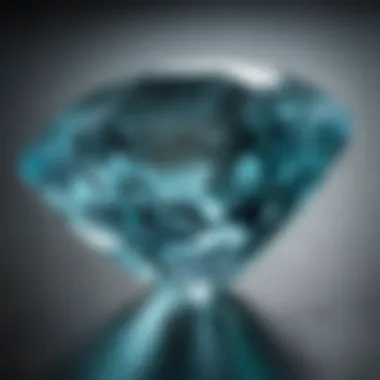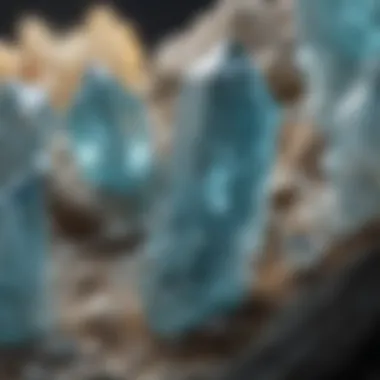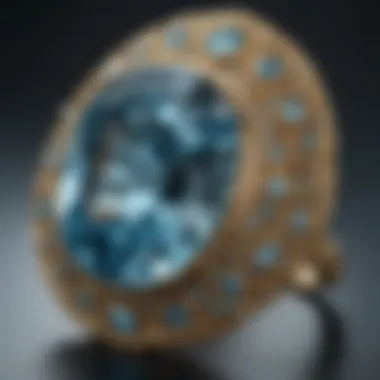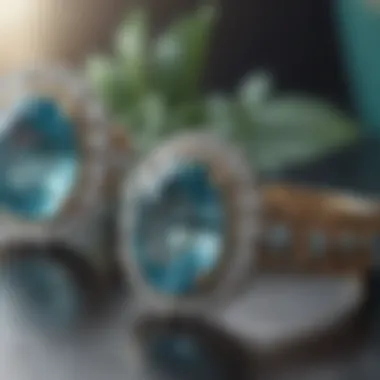Understanding Aquamarine: The Birthstone of March 29th


Intro
Aquamarine, the birthstone for those born on March 29th, holds a distinctive place in the world of gemstones. This stone's allure is not just its beauty but also its rich history and multifaceted significance. As we delve into the various aspects of aquamarine, we will uncover its unique characteristics, its journey through time, and its relevance in contemporary culture. This exploration is designed for both enthusiasts and professionals within the gemology field.
Gemstone Overview
Definition and Characteristics
Aquamarine, part of the beryl family, is a gemstone that exhibits a range of blue to blue-green hues. This color is primarily due to the presence of iron. Typically, high-quality aquamarine has a clear and vivid color, which is highly valued in jewelry making. The stone is often transparent, with a glassy luster that enhances its visual appeal. Its hardness, rated at 7.5 to 8 on the Mohs scale, makes it a durable choice for everyday wear.
Classification of Gemstones
Gemstones can be broadly classified into two categories: precious and semi-precious. Aquamarine is often considered a precious gemstone due to its rarity in high-quality forms. The classification also extends to its geological formation, with aquamarine sourced from both igneous and metamorphic rocks. Mining locations include Brazil, Nigeria, and Madagascar, each producing stones with different qualities and characteristics.
Historical Significance
Ancient Uses and Cultural Importance
Aquamarine has been revered since ancient times. The Greeks believed it was sacred to Poseidon, the god of the sea, and used it for protection during maritime journeys. Ancient sailors would carry aquamarine talismans to ensure safety and calm seas. Additionally, it was favored in jewelry by the Romans, who crafted intricate pieces, showcasing the gem's beauty.
Myths and Legends Surrounding Gemstones
Throughout history, aquamarine has been associated with various myths. Many cultures believed it brought harmony and tranquility. It was often said to have the power to dispel fears and enhance communication. These metaphysical beliefs contributed to its popularity among both the elite and common people alike.
"Aquamarine, known as the sailor's gem, symbolizes tranquility and calm waters."
The stone is not just a beautiful adornment but carries with it centuries of lore that enriches personal significance for its wearers.
In summary, aquamarine is a gemstone that encapsulates both beauty and rich historical significance. The understanding of this birthstone extends beyond its visual attributes. It provides insights into the cultural and metaphysical dimensions that have surrounded it for ages. As we continue to explore aquamarine in contemporary contexts, we will see how its allure persists in modern gemstone culture.
Prelims to March Birthstones
The exploration of March birthstones is significant for both birthstone enthusiasts and those interested in jewelry. Each month is associated with specific stones, which reflect the qualities of those born in that period. This connection enhances the cultural and personal significance of the gemstones. For March, aquamarine stands out not only for its aesthetic appeal but also for its historical and metaphysical attributes. Understanding these gemstones can deepen our appreciation and guide better choices regarding purchases and uses.
Overview of Zodiac Months and Corresponding Gems
Each month of the year corresponds to certain gemstones, often referred to as birthstones. These stones hold unique meanings and properties, linked to the astrological signs of those born within each month. For example, January is linked to garnet, while February corresponds to amethyst. The significance of these stones extends from history into modern culture. Familiarity with these associations allows individuals to connect personally with their birthstones and can guide them in their choices of jewelry, gifts, and spirituality. The zodiac signs underpinning each month reflect personality traits and characteristics, further enhancing the significance of each corresponding gemstone.
The Unique Position of March 29th
March 29th is a date that falls under the astrological sign of Aries. This sign is known for its boldness and leadership qualities. Those born on this day may possess a spirited personality, driven by a desire for adventure and new experiences. Aquamarine, the birthstone for March, resonates particularly well with these attributes. Its calming qualities can counterbalance the fiery nature of Aries, promoting serenity amidst the passion. This unique position provides March 29th individuals not only with a distinct birthstone but also with a symbolic representation of their character. Understanding this relationship offers a deeper insight into the personal significance of aquamarine for those celebrating their birthdays on this date.
Aquamarine as the Birthstone
Aquamarine holds a prominent place as the birthstone for those born on March 29th. This gemstone is valued not just for its aesthetic appeal but also for its numerous associations with various benefits and meanings. Understanding these aspects is crucial for anyone interested in aquamarine, whether it be for personal connection or as part of jewelry design.
Scientific Properties of Aquamarine
Aquamarine is a member of the beryl family. Its chemical formula is Be3Al2(SiO3)6, indicating the presence of beryllium and aluminum. The stone typically exhibits a hexagonal crystal structure, which contributes to its unique transparent appearance. Aquamarine is most commonly found in colors ranging from light blue to deep blue-green, colored primarily by traces of iron.
One notable feature of aquamarine is its clarity. High-quality specimens can appear almost glass-like without inclusions. Moreover, aquamarine has a hardness of 7.5 to 8 on the Mohs scale, making it suitable for various types of jewelry. Its durability adds to its value as a birthstone, appealing to those looking for a stone that can withstand daily wear.


Color Variations and Quality Indicators
Aquamarine's color range is one of its most captivating elements. The most sought after hues are a rich, ocean-like blue. However, it can also come in various shades, including pale blue, teal, and even slightly greenish tones. The spectrum of colors can indicate different quality levels. For example:
- Light Blue: Generally more affordable and can appear washed out.
- Medium Blue: Often seen as ideal, providing a balance between color depth and cost.
- Deep Blue: Rare and expensive due to its vivid saturation.
When selecting aquamarine, clarity is a critical factor. Look for stones free of visible inclusions, particularly because clarity enhances both the beauty and value. Cut also plays a role; well-cut stones reflect light brilliantly.
"The beauty of aquamarine lies in its myriad of shades, each telling a unique story of its formation and structure."
Historical Context of Aquamarine
The historical context of aquamarine provides valuable insights into its significance across time. This section explores how the gemstone has been utilized in various cultures and how these traditions have shaped its identity. Understanding its history allows us to appreciate aquamarine not only as a beautiful jewel but also as a symbol of wealth and protection, particularly in maritime settings.
Uses in Ancient Cultures
Aquamarine has held a special place in many ancient cultures. The stone was often associated with the sea, making it a favorite among sailors. The Romans believed that aquamarine was the treasure of mermaids and believed it had the power to ensure safe passage through turbulent waters. Similarly, the ancient Egyptians revered aquamarine as a protective talisman, embedding it in their burial artifacts to safeguard their journeys into the afterlife.
In addition, this gem was used in jewelry that adorned royalty, which showcased its value and beauty. Historical records indicate that aquamarine was favored by the ancient Greeks and was believed to have links with the god Poseidon. The gem was often engraved with symbols of the sea, enhancing its mystique and appeal.
Significance in Maritime Traditions
Aquamarine’s significance in maritime traditions cannot be overstated. Throughout history, sailors have viewed aquamarine as a protective stone. They believed it would keep them safe from perils at sea and provide clarity of thought during challenging conditions. Aquamarine was often carried aboard ships or worn as jewelry to ward off misfortune and to promote tranquility on tumultuous waters.
In many coastal cultures, aquamarine was seen as a gift from the ocean, embodying its calming blue colors. Fishermen would wear aquamarine amulets, believing these would assure bountiful catches and protection from storms. This historical connection to the sea enhances the gem's allure, intertwining it with adventure and exploration.
Aquamarine was not merely a decorative item; it was a vessel of hope and safety, deeply embedded in the lives of those who depended on the sea.
In summary, the historical context of aquamarine showcases its central role in ancient cultures and maritime traditions. Understanding these connections helps individuals appreciate the depth of meaning behind this remarkable gem. Whether seen as a protective talisman or a symbol of wealth, aquamarine continues to evoke admiration and respect in the world of gemstones.
Metaphysical Properties of Aquamarine
The metaphysical properties of aquamarine extend beyond its physical beauty. Aquamarine is often regarded as a stone that embodies the essence of the sea. Its soothing blue hues are believed to promote tranquility and clarity of thought. This section elucidates the emotional and spiritual benefits associated with aquamarine, followed by its applications in healing practices.
Emotional and Spiritual Benefits
Aquamarine is said to foster calmness and emotional balance. It encourages the release of stress and aids in overcoming fear. For many, possessing or wearing aquamarine brings inner peace, especially during turbulent times. This stone is frequently utilized in meditative practices. By focusing on aquamarine, one may feel a greater connection to their inner self. Additionally, it helps in expressing one’s feelings, promoting clear communication without anxiety or frustration. Many users report improved relationships both personally and professionally after being in contact with aquamarine. These emotional and spiritual benefits create a strong allure around the stone, making it popular among enthusiasts and practitioners.
Aquamarine in Healing Practices
The application of aquamarine in healing practices is noteworthy. In various alternative medicine practices, it is employed to alleviate anxiety and enhance mental clarity. Practitioners of crystal healing often place aquamarine on areas of the body where stress and tension accumulate. It is thought to support the thyroid and hormone balance. Some also associate it with strengthening the immune system.
Aquamarine is often used in conjunction with tapping techniques or energy healing methods. Practitioners believe that holding aquamarine while meditating can amplify the positive energies, leading to better emotional resilience. Many patients claim to experience a sense of ease and comfort when the stone is present. Therefore, aquamarine is not just an aesthetic choice; its metaphysical properties make it a tool for many seeking emotional stabilization and physical healing.
Selecting Aquamarine Jewelry
Selecting aquamarine jewelry is crucial for anyone who appreciates this stunning gemstone. Not only does aquamarine offer a wide variety of aesthetic appeals, but it also possesses unique qualities that make it suitable for various occasions. Understanding how to choose aquamarine jewelry means recognizing the specific characteristics of the stone, along with the benefits it can bring to the wearer.
Understanding Quality Grades
The quality of aquamarine is classified based on specific criteria. These include color, clarity, cut, and carat weight. Each category plays a vital role in determining the overall value and aesthetic of the stone.
- Color: The most sought-after hues of aquamarine are shades of blue and blue-green. A vivid, even color is often indicative of a high-quality example.
- Clarity: This refers to the presence of inclusions. A higher clarity gemstone will generally be more valuable. Look for stones that are clear or have only minimal inclusions visible.
- Cut: The cut affects how light interacts with the stone. A well-cut aquamarine will showcase the gem’s clarity and color effectively, enhancing its overall beauty.
- Carat Weight: Larger stones tend to be more sought after, but the aforementioned qualities often weigh more heavily in terms of value.


Each of these grades contributes to not only the aesthetic but also the long-term value of the jewelry piece. When investing in aquamarine jewelry, being aware of these factors can greatly influence your satisfaction and perception of value.
Factors to Consider for Purchases
When buying aquamarine jewelry, several factors should be taken into account. To make informed choices, consider the following elements:
- Source of the Gemstone: Understanding where the aquamarine is sourced can give insights into its quality and authenticity. Brazilian aquamarines are often noted for their exceptional color and clarity.
- Jewelry Settings: The setting can significantly impact the overall appearance of the piece. Popular settings for aquamarine include white gold and platinum, which enhance the cold tones of the stone.
- Certification: Always check for certification from reputable gemological institutions. Certified stones ensure that the seller accurately represents the attributes of the aquamarine.
- Personal Style: Consider your own style preferences, as aquamarine can complement a variety of looks. Decide whether you prefer elegant pieces for formal occasions or more casual designs.
- Budget: Establish a clear budget prior to searching. Aquamarine can vary widely in price, from more affordable options to luxury pieces.
Selecting the right aquamarine jewelry requires careful consideration, balancing aesthetic preferences, quality, and personal value.
Caring for Aquamarine
Caring for aquamarine is essential for preserving its beauty and value. This stone, known for its delicate color and clarity, requires specific attention to maintain its lustrous appearance. Proper care not only enhances the gem's visual appeal but also extends its lifespan. When considering aquamarine jewelry, it is prudent to understand both the cleaning techniques that suit this stone and the long-term care practices that can prevent damage.
Recommended Cleaning Techniques
Cleaning aquamarine should be done with care to avoid scratching or dulling its surface. Here are some suggested methods:
- Use Mild Soap and Water: A gentle solution of warm water and mild liquid soap works best. Submerge the jewelry for a few minutes, then gently wipe with a soft cloth or a soft-bristle toothbrush. Rinse thoroughly to remove any soap residue.
- Avoid Harsh Chemicals: It is critical to refrain from using chemicals like bleach or ammonia, as these can damage the gemstone's surface and lead to discoloration.
- Skip Ultrasonic Cleaners: While some stones benefit from ultrasonic cleaners, aquamarine is best cleaned manually. The vibrations can cause cracks or eliminate the brilliance.
“Gentle cleaning goes a long way in preserving the beauty of aquamarine.”
By following these methods, you maintain the gemstone's vibrant hue.
Long-Term Care Tips
Beyond immediate cleaning practices, long-term care is crucial for those who own aquamarine jewelry. Here are some tips to follow:
- Store Properly: Keep aquamarine pieces stored separately in a soft cloth pouch or a jewelry box lined with fabric to prevent any scratches from contact with other hard materials.
- Avoid Extreme Conditions: Prolonged exposure to extreme temperatures or humidity can adversely affect aquamarine. Avoid leaving jewelry in direct sunlight or near radiators to maintain its structural integrity.
- Regular Inspections: Periodically inspecting your aquamarine jewelry for signs of wear can help catch any issues early. Check for loose settings or scratches, which can be repaired before they worsen.
Overall, taking these steps ensures that aquamarine remains a cherished part of your collection for years to come.
Cultural Significance of Aquamarine
Aquamarine holds a special place in various cultures, embodying not just beauty but also deeper meaning. It serves as a connection to the sea, often associated with tranquility and clarity. Its blue hues evoke thoughts of calmness, making it a favored stone in various traditions. Exploring the significance of aquamarine helps us understand how it shaped beliefs and practices across generations.
Symbolism in Different Cultures
In ancient times, aquamarine was revered for its protective qualities. Sailors carried this stone, believing it would ensure safe passage across turbulent waters. The Romans connected the gem with Neptune, the god of the sea. They thought aquamarine would calm storms and prevent shipwrecks, symbolizing a bridge between the physical and spiritual realms.
Similarly, in ancient Egypt, this gemstone symbolized fertility and rebirth. It was often set in jewelry for pharaohs, representing protection and immortality. The turquoise hue of aquamarine also signifies life and renewal in various cultures.
- Ancient Greeks viewed aquamarine as a gift from the sea, signifying the goddess Aphrodite’s favor. They believed it brought love and peace, present in both personal and communal rituals.
- Chinese culture associates certain shades of aquamarine with health and prosperity. Use of aquamarine in talismans was common, and it was thought to promote harmony within the family.
The stone’s associations with the ocean make it symbolic of purity and healing. This underscores its value beyond mere aesthetics, drawing connections between emotional stability and the natural elements.
Aquamarine in Literature and Art
The presence of aquamarine in literature reveals its significance in human expression. Writers have long admired its beauty, using it to symbolize clarity of thought and emotional balance. For example, in various poems, aquamarine often appears as a metaphor for love and serenity, highlighting its calming attributes.
In art, aquamarine serves not just as a color but also as a focal point in jewelry and sculptures. Artists found inspiration in its clear, watery shades, often incorporating the stone into their works to convey themes of tranquility and depth.
Additionally, notable pieces include jewelry worn by royal families, showcasing the connection between power, beauty, and symbolism in human culture. Aquamarine has been depicted in many art forms, from paintings to intricate jewelry, emphasizing its role as a symbol of grace and elegance.


"Aquamarine speaks softly of the ocean's depths and the clarity of emotions, making it a source of inspiration across various forms of artistic expression."
In summary, the cultural significance of aquamarine transcends geography and time. Its symbolism and representation in different cultures reflect human experiences and aspirations. Recognizing the deeper meanings behind aquamarine enriches our understanding of its role in both historical and modern contexts.
Market Trends for Aquamarine
Understanding market trends for aquamarine is crucial for anyone involved with gemstones. This includes enthusiasts, collectors, jewelers, and investors. The pricing, demand, and overall perception of aquamarine can shift, influenced by various factors. When one grasps the current landscape of aquamarine's market, they can make informed decisions about purchases, sales, and investment opportunities.
Factors like supply chain disruptions, mining developments, and global economic conditions play a significant role in determining the market dynamics. As aquamarine is sourced primarily from locations like Brazil, Nigeria, and Madagascar, local events in these countries can greatly impact prices and availability. As such, knowledge about market trends becomes essential for anyone interested in aquamarine.
Current Market Analysis
The current market analysis of aquamarine shows a complex picture. In recent years, there has been an increasing interest in this gemstone. Both individuals and institutions are investing in aquamarine, drawn by its beauty and the allure surrounding its origin. The gemstone’s color and clarity influence its market value significantly. Recent trends indicate that there is a growing interest in high-quality stones, which has caused prices for fine aquamarine to rise steadily.
Key points regarding the current market include:
- Price Fluctuations: The average price per carat can vary. It may start from reasonable rates but can escalate substantially for higher-grade specimens.
- Collectability: Unique and rare pieces are becoming highly sought after. This trend can be seen in auctions and private sales.
- Sustainability: More buyers are interested in ethically sourced gemstones, driving demand for responsibly mined aquamarine.
Understanding these elements is vital. Investors and collectors should keep a close eye on market reports and sales to better comprehend valuation shifts.
Investment Potential of Aquamarine
Aquamarine has been emerging as a popular investment choice among gemstones. Its appeal is not just due to its visual charm but also its potential for appreciating value over time. As a relatively accessible gemstone, it strikes a balance between beauty and investment viability.
Potential investors should consider the following when evaluating aquamarine:
- Quality and Rarity: Higher quality stones that feature vivid colors and clarity tend to hold more value.
- Historical Significance: Older pieces can fetch a premium if they have documented provenance.
- Market Demand: The growing interest in colored gemstones can positively affect aquamarine's market performance.
In summary, being aware of market trends aids not only in appreciating the beauty of aquamarine but also in recognizing its potential for investment gains. With the right knowledge, one can navigate the evolving landscape of this captivating stone.
Aquamarine in Modern Fashion
Aquamarine's role in modern fashion showcases the gemstone's versatility, appeal, and timeless quality. As a birthstone for those born on March 29th, aquamarine not only carries emotional significance but also adds aesthetic value to various jewelry pieces. The current fashion landscape embraces aquamarine, making it a popular choice for both everyday wear and special occasions.
Trends in Jewelry Design
Contemporary jewelry design has seen a resurgence of natural gems, including aquamarine. The light blue hue of aquamarine complements a spectrum of styles, from minimalist to extravagant.
- Clean Lines: Many designers now favor sleek, simple designs that keep the focus on the beauty of the aquamarine itself.
- Mixed Materials: Aquamarine is often paired with materials like gold, silver, and even rose gold, enhancing its transparency and vibrancy.
- Statement Pieces: Large aquamarine stones in cocktail rings or necklaces have become statement pieces in various collections. These bold designs often feature intricate settings that highlight the stone's clarity, making each piece a conversation starter.
- Customization: More consumers seek personalized jewelry, driving designers to create custom pieces incorporating aquamarine. This allows individuals to express their unique styles or commemorate special moments.
Aquamarine on Red Carpets
Aquamarine's elegance has not gone unnoticed in celebrity culture. On red carpets, aquamarine shines as a choice for high-profile figures, providing a refreshing alternative to more traditional gemstones. Its serene color complements a variety of outfits, from bright dresses to classic black gowns.
Aquamarine has increasingly become a red carpet favorite due to its ability to catch the light beautifully while offering a unique color that stands out.
Celebrities like Rihanna and Blake Lively have been spotted wearing aquamarine jewelry at major events, showcasing the gemstone's stunning appeal. The bluish tint enhances their ensemble, giving a sophisticated yet youthful look. The fashion industry recognizes aquamarine not just as a birthstone but as a trendsetter, making it a go-to choice for jewelry designers and fashionistas alike.
Culmination: Embracing Aquamarine
In the exploration of aquamarine's significance, several key factors clearly stand out. Understanding aquamarine as the birthstone for individuals born on March 29th goes beyond mere aesthetics. It reflects a rich tapestry of history, culture, and personal meaning. The aquamarine is valued not just for its stunning hues but also for the emotional and spiritual benefits it is believed to provide.
Summary of Aquamarine's Importance
Aquamarine holds a prominent position among gemstones typically associated with March. Its cool blue to green shades symbolize tranquility, calmness, and clarity. The stone is thought to empower individuals, aiding in communication and expression. Moreover, its historical relevance dates back to ancient civilizations that revered it for protective qualities during maritime journeys. Owning or wearing aquamarine can serve as a reminder of one's roots or aspirations. This gemstone's unique properties make it an enduring choice for both jewelry enthusiasts and collectors alike. The qualities of aquamarine can enhance its appeal, making it suitable for various types of adornments, from rings to necklaces.
Final Thoughts on Aquamarine for March 29th Birthdays
Individuals born on March 29th can take pride in their connection to aquamarine. This stone embodies qualities that align harmoniously with their supposed traits, such as creativity, depth, and intuition. Choosing aquamarine as a birthstone conveys a timeless message about appreciating the beauty and significance of gemstones. As people continue to gravitate towards personal connections with their birthstones, aquamarine remains a vivid symbol of strength and serenity. It invites introspection and encourages those who celebrate their birthday on this special date to embrace the foundational meanings enclosed within this stunning gem.







